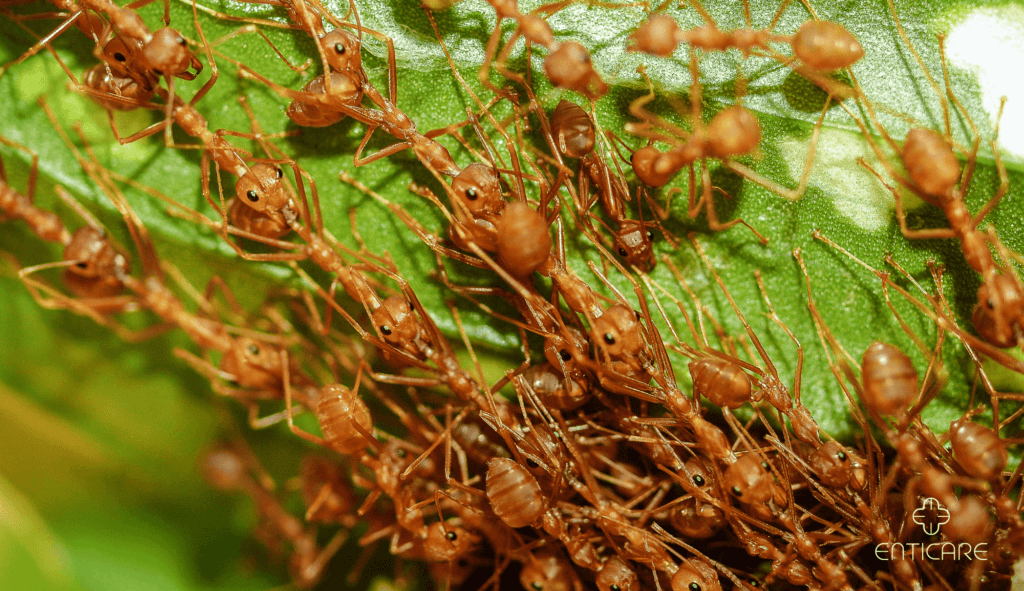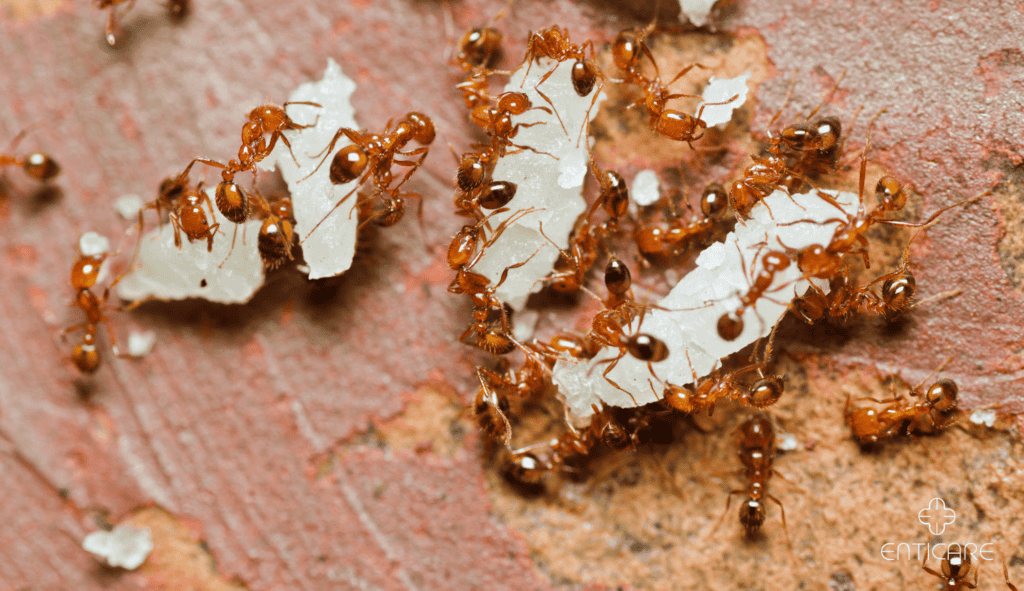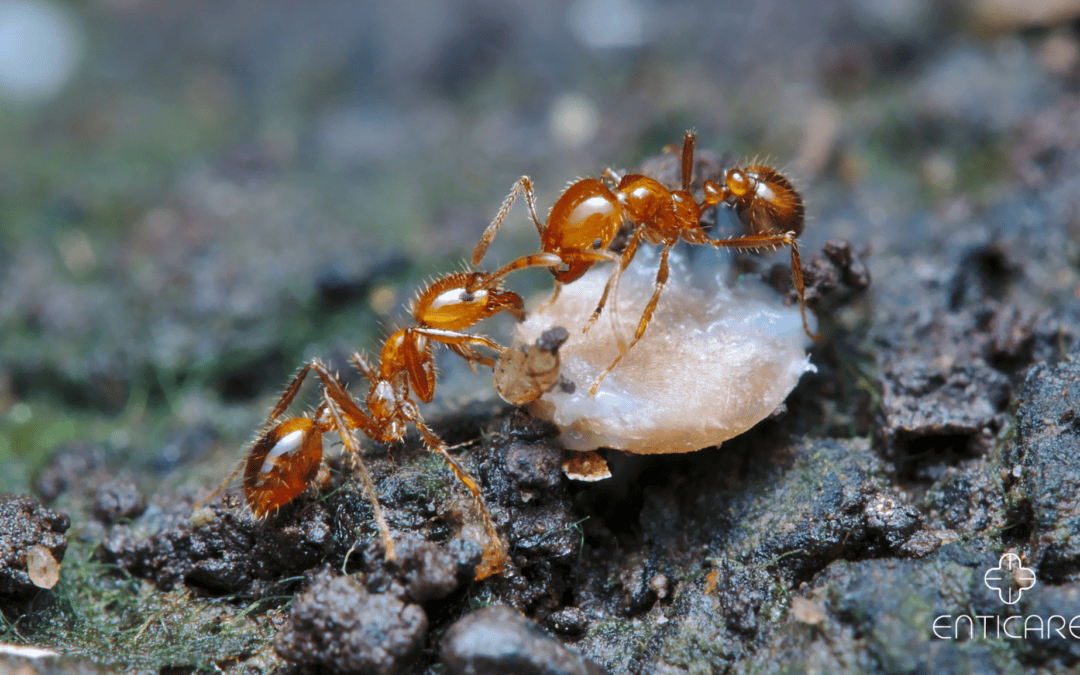Fire ant allergies can cause severe reactions and discomfort, making it essential to understand how to manage them effectively. This guide will cover the diagnosis, treatment, and prevention of fire ant allergies, including the symptoms and reactions to a fire ant bite, providing you with the knowledge you need to get fire ant bites and stay safe and healthy. By taking proactive steps, you can reduce the risk of allergic reactions and enjoy a better quality of life.

Understanding Fire Ant Allergies
What Causes Fire Ant Allergies?
Fire ant allergies occur when your immune system reacts to the venom injected by fire ants during a sting. This venom contains proteins that can trigger an allergic reaction in some individuals. Fire ants are aggressive and will sting repeatedly if they feel threatened, increasing the amount of venom delivered. Fire ants, specifically Solenopsis invicta and Solenopsis richteri, are native to South America and have spread to multiple states in the U.S.
Symptoms of Fire Ant Allergies and Severe Allergic Reactions
Symptoms of fire ant allergies can range from mild to a severe reaction. Mild reactions include itching, redness, and swelling at the sting site. Moderate reactions may involve hives, nausea, and difficulty breathing. Severe reactions, known as anaphylaxis, can include swelling of the throat, difficulty swallowing, rapid pulse, and a drop in blood pressure, which can be life-threatening if not treated promptly. Initial symptoms of a fire ant bite include stinging pain, a burning sensation, and the development of itchy red bumps and fluid-filled blisters.
Who is at Risk?
Anyone can develop an allergy to fire ants live to ant stings, but certain factors increase the risk. Individuals with a history of allergies or asthma may be more susceptible. Those living in areas where fire ants are prevalent, such as the southeastern United States, face a higher risk of being stung. Additionally, people who spend a lot of time outdoors, including gardeners, hikers, and farmers, are at greater risk of encountering fire ants.
Diagnosing Fire Ant Allergies
Medical History and Physical Examination
The first step in diagnosing fire ant allergies involves a thorough medical history and physical examination. Your doctor will ask about your symptoms, the timing of the reactions, and any previous allergic reactions to insect stings. They will also examine the sting site for signs of an allergic reaction, such as swelling and redness. After a fire ant bite, it is important to wash the area with soap and water and apply a cold compress to reduce pain and swelling.
Skin Prick Testing
Skin prick testing is a common method for diagnosing fire ant allergies. During this test, the doctor places a small amount of fire ant venom extract on your skin and pricks the skin to introduce the allergen. If you are allergic red fire ants, a raised, red bump will appear at the test site within 15 to 20 minutes. This test helps confirm the presence of an allergy and its severity.
Blood Tests
Blood tests can also help diagnose fire ant allergies. Specific IgE blood tests measure the levels of antibodies to fire ant venom in your blood. High levels of these antibodies indicate an allergic reaction to fire ant. Blood tests are particularly useful for individuals who cannot undergo skin prick testing due to severe skin conditions or other medical reasons.

Treating Fire Ant Allergies
Immediate Treatment for Stings
Immediate treatment is crucial when dealing with fire ant stings. Wash the affected area with soap and water to remove venom and reduce the risk of infection. Apply a cold compress to the sting site to reduce swelling and pain. Over-the-counter antihistamines can help with severe swelling and alleviate itching and mild allergic reactions. For severe reactions, seek emergency medical attention immediately.
To prevent fire ant stings, avoid stomping on fire ant mounds and check for fire ants indoors.
Medications
Several medications can help manage fire ant allergies. Antihistamines, both oral and topical, can reduce itching, redness, and swelling. Corticosteroid creams or ointments can also help alleviate skin inflammation. For moderate to severe allergic reactions black fire ants, your doctor may prescribe oral corticosteroids or epinephrine injectors (EpiPens) to manage symptoms and prevent anaphylaxis.
Immunotherapy
Immunotherapy, or allergy shots, is an effective long-term treatment for fire ant allergies. This treatment involves receiving regular injections of gradually increasing doses of fire ant venom. Over time, your immune system becomes less sensitive to the venom, reducing the severity of allergic reactions. Immunotherapy can significantly less severe allergic reaction, decrease the risk of anaphylaxis and improve your quality of life.
How to Prevent Fire Ant Stings
Avoiding Fire Ant Habitats
Preventing fire ant stings starts with avoiding their habitats. Fire ants build mounds in sunny, open areas such as lawns, parks, and fields. Be cautious when walking or working in these areas, especially after rain, as fire ants become more active. Wear protective clothing, such as long sleeves, pants, and closed-toe shoes, to minimize exposed skin.
Fire ants are native to South America and have spread to multiple states in the U.S.
Home and Yard Maintenance
Maintaining your home and yard can help reduce the presence of fire ants. Regularly inspect your property for fire ant mounds and treat them with insecticides if fire ant mound is found. Keep your lawn well-maintained, and remove debris where fire ants can nest. Sealing cracks and gaps in your home’s foundation and walls can prevent fire ants from entering your living spaces.
Personal Protective Measures
Taking personal protective measures can also help to prevent fire ant bites and stings. Use insect repellents containing DEET on exposed skin and clothing. Be vigilant when working or playing outdoors, and avoid disturbing fire ant mounds. If you have a known fire ant allergy, always carry an epinephrine injector and a medical alert bracelet to inform others of your condition in case of an emergency. Additionally, avoid stomping on fire ant mounds and check for fire ants indoors to prevent fire.

Managing Fire Ant Allergies in Daily Life
Creating an Allergy Action Plan
Creating an allergy action plan is essential for managing fire ant allergies. This plan should include steps to take in case of a fire ant sting, medications to carry, and emergency contacts. Share this plan with family members, friends, and coworkers to ensure they know how to help if you experience an allergic reaction. Regularly review and update your action plan to keep it current.
Educating Others
Educating others about fire ant allergies can help prevent stings and future allergic reactions and ensure prompt treatment. Teach your family and friends about the risks and symptoms of fire ant allergies. Encourage them to take preventive measures and to be aware of your allergy action plan. In schools and workplaces, provide information about fire ant allergies and how to respond to allergic reactions.
Regular Medical Check-ups
Regular medical check-ups are crucial for managing fire ant allergies. Schedule appointments with your allergist to monitor your condition and adjust your treatment plan as needed. Discuss any new symptoms or concerns with your doctor to ensure you receive appropriate care. Regular check-ups can help you stay informed about your allergy and maintain your health.
Conclusion
Fire ant allergies can be challenging to manage, but with the right knowledge and strategies, you can reduce the risk of stings and allergic reactions. By understanding the causes, symptoms, and treatments of fire ant allergies, you can take proactive steps to protect yourself and improve your quality of life.
Take control of your fire ant allergies today. Schedule an appointment with our experts at Enticare to discuss your symptoms and develop a personalized treatment plan. Dial 480-214-9000 and take the first step toward wellness.

